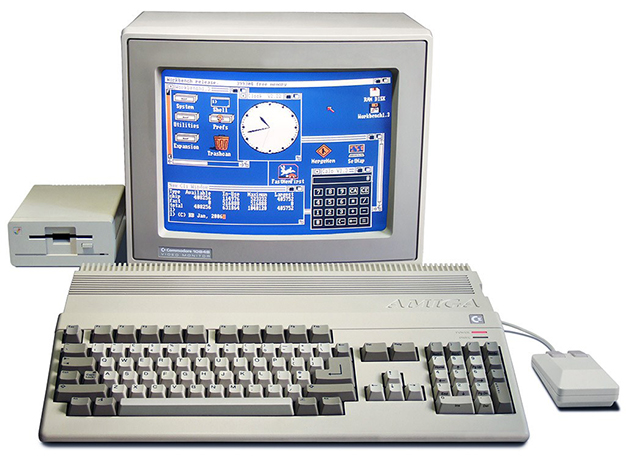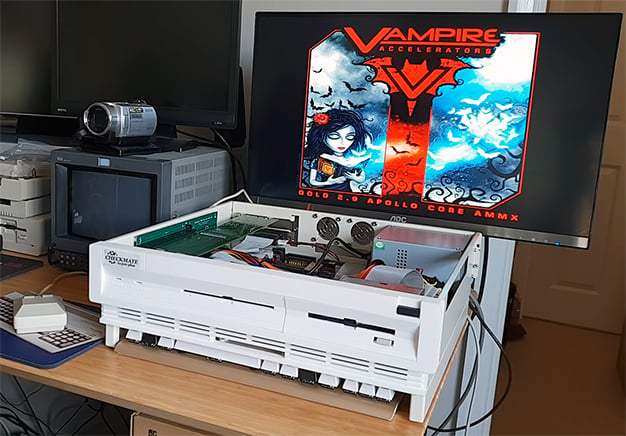Revitalization Of Commodore's Amiga Continues With Exciting New Retro Hardware

In that previous post, we showed you some freshly-minted Amiga motherboard PCBs that were reverse engineered by a couple of members of the Amiga community. We also shined the spotlight on the Vampire 4, a Altera FPGA-based device that could eventually be the foundation – or at the very least a precursor -- of a new, standalone Amiga platform in the future.
Those projects are hardly the only ones going on, however. In fact, John “Chucky” Hertell, who created the Re-Amiga 1200 PCB mentioned in our previous article, recently hinted that he may tackle the Amiga 3000 next. And Paul Rezendes’ replica Amiga 4000 motherboards were originally inspired by user “Hese” from the Amibay forums who did something similar, but with a different revision of the A4000 motherboard PCB.
Since then, Hese has taken his project a step further and created an E-ATX-compatible version of the Amiga 4000 motherboard PCB, dubbed the A4000TX, that’s compatible with modern chassis designs. In addition to virtually all of the original functionality of the Amiga 4000 motherboard, Hese also tweaked the IO port arrangement to conform to the ATX form factor, added PS/2 compatible mouse and keyboard ports (though those still need some fine tuning), and a header for attaching scan doublers, genlocks, a SCART output, and the like.
The goal for Hese’s latest project was to create an Amiga motherboard that would fit in modern ATX cases and still support full-length Zorro Amiga expansion cards. Because the bottom portion of the PCB had to be extended to support the longer Zorro slots, the A4000TX won’t fit every ATX chassis – hence the E-ATX recommendation. However, if the ATX chassis has room at the bottom, the A4000TX can still be shoehorned in. Hese actually shows pictures of the board mounted in a standard Enlight ATX chassis, that doesn’t support E-ATX.
Another longer-term project making news is the Checkmate A1500 Plus. The Checkmate A1500 Plus is a brand-new case inspired by the design of the Amiga 3000 that's being developed by Stephen Jones, formerly of Checkmate Digital.
Way back in the day, Checkmate Digital sold what it called an A1500. At the time, the Amiga 2000 was king, but it was extremely expensive. The Amiga 500, which was also available, was relatively affordable, but it’s all-in-one, wedge-shaped design limited expandability and put off potential business customers. With the A1500, Checkmate Digital wanted to create a low-cost Amiga with a typical desktop form factor and detached keyboard that could also be more expandable with bays for additional drives, expansion cards, and accelerators. Checkmate Digital pulled it off by creating a custom chassis and keyboard case that could accommodate the Amiga 500’s motherboard and keyboard assembly. They would essentially buy Amiga 500 bundles, pull them apart, assemble them in the A1500 chassis, and resell everything. Before Commodore ran them out of business with its own Amiga 1500, Checkmate’s machines were well-received.
With the Checkmate A1500 Plus Stephen Jones is back at it, but this latest case design can accommodate Amiga 500, 600, and 1200 motherboards, mini-ITX and micro-ATX motherboards, the Raspberry Pi, and the upcoming standalone Vampire V4. The design is done and a Kickstarter is underway in an attempt to get the molds created for all of the plastics and begin final production.
This past weekend, while promoting the Checkmate A1500 Plus Kickstarter campaign, Trevor Dickinison also caused a stir with a proclamation of his own. Trevor Dickinson is one of the co-founders of A-EON Technology, the makers of the Amiga X5000. For a couple of years, his company has been working on a mini-ITX motherboard dubbed the "Tabor" A1222 that’s destined for lower-cost, modern Power-PC based Amigas.
Many in the Amiga community have been eagerly anticipating Tabor, due to the relatively high cost of the X5000, but its development has dragged on for quite some time. Mr. Dickinson mentioned in his post, however, that if the Checkmate A1500 Plus achieves its funding goal, the A1222 Tabor will be "ready and waiting" to ship alongside the case in May 2019.
A couple of days ago, the Apollo Team also made the first public release of its Core 3 Alpha firmware for the Vampire. Core 3 is the next step in the Vampire’s evolution, which incorporates AGA (Amiga Advanced Graphics Architecture) compatibility, necessary for some late model Amiga / CD32 games and demos. With Core 3, the Apollo Team also intends to incorporate things like audio out over HDMI, to make connecting a Vampirized Amigas to modern displays quick and easy.
The Vampire 4 Running AGA Quake
For those unfamiliar, the Vampire is an Altera FPGA-based device that recreates the Motorola 680x0 class CPU and custom Amiga chips in the FPGA. The Vampire V2 has been out for a while now, but the upcoming V4 is a more powerful iteration that will be sold in a few configurations, including one that will function as a standalone Amiga system. It can also be used as an add-in accelerator card for some classic Amiga’s though.
The Vampire V4 is outfitted with 512MB of memory (spec'd at 1GB/s) and an Altera Cyclone V A5 SoC, in addition to a handful of necessary headers, inputs, and outputs. The video above was just posted and shows a Vampire V4-equipped Amiga 500 running AGA Quake, something that couldn’t be done on older Amigas because they lacked the necessary chipset.




